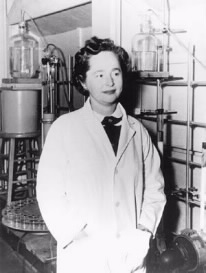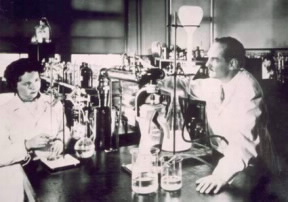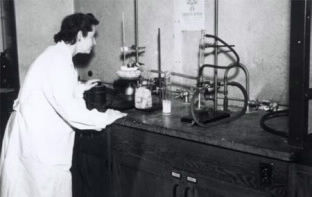Gertrude Elion (1918–1999)
Leukemia, Herpes Drug Pioneer
Gertrude Elion (1918–1999) and colleague George Hitchings (1905–1998) went off the beaten path of trial-and-error drug development to revolutionize drug making. Using a method known as “rational drug design,” Elion and Hitchings were able to successfully interfere with cell growth, giving way to a number of effective drugs for treating leukemia, gout, malaria, herpes, and many other illnesses.
Academic Highs and Lows
Elion decided to dedicate her life to medicine after the deaths of her grandfather from stomach cancer and fiancÉ from an inflammation of the heart lining. In 1937, she graduated summa cum laude from Hunter College with a degree in chemistry, but her hopes of becoming a research scientist were dashed by 15 rejections for financial assistance from graduate schools throughout the country. Not only did she face discrimination in academia, she also couldn’t land a job because of her gender, so she enrolled in secretarial school. Looking back, she said: “I hadn’t been aware that any doors were closed to me until I started knocking on them.”
While volunteering in a chemistry lab that could only offer her a dishwashing job, an opportunity opened up at Burroughs Wellcome Company. This enabled her to save money for graduate work at New York University, where she was the only woman in her chemistry classes.

Elion completed her masters degree in 1941, but it wasn’t until 1944 that she would be hired as a research chemist by Johnson & Johnson. Later that year, Elion was offered another position working with nucleic acids alongside Hitchings at Burroughs Wellcome Company. She also enrolled as a doctoral student at Brooklyn Polytechnic Institute (now Polytechnic Institute of New York University), where she took evening courses. Faced with a decision to enroll full-time to complete a Ph.D. or to continue on as a research chemist, Elion elected to side with the research at Wellcome with Hitchings, rather than pursue her doctoral degree.

“Rational” Research for Leukemia
At the lab, Hitchings had been looking for a more “rational” method of research. The introduction of sulfa drugs inspired him to consider that other substances that interfere with the metabolism of microbes could also be developed as drugs. His approach was to observe the differences in nucleic acid (DNA and RNA) metabolism among protozoa, normal human cells, and abnormal cells (e.g., cancer cells, bacteria and viruses).
Hoping to develop drugs that selectively block the growth of cancer cells and poisonous organisms, Hitchings assigned Elion to investigate organic compounds called purines—specifically, the purine bases adenine and guanine, which are building blocks of DNA. They soon discovered, from observing the role of purines in nucleic acid metabolism, that bacterial cells require certain purines to make DNA. Hitchings hypothesized that by preventing those purines from entering the metabolic pathway that leads to DNA synthesis, they could stop the production of DNA and thereby stop cell growth.
Along the way, Elion published 225 papers on her findings. By 1950, Hitchings and Elion successfully synthesized two compounds—diaminopurine and thioguanine—which attract metabolic enzymes to latch onto them instead of natural purines, thereby blocking DNA production. For the first time, a treatment that could interfere with the formation of leukemia cells was now available to put Leukemia patients in remission.
While the new chemotherapy drugs proved effective in treating the cancer, they were too toxic and caused severe vomiting. Elion began searching for a less poisonous compound, testing over 100 purine compounds. She finally discovered 6-mercaptopurine (6-MP), which she created by replacing one sulphur atom with an oxygen atom.

In testing, mouse tumors failed to grow, and treated mice live twice as long as those left untreated. Children given the treatment went into complete remission, but they were not cured. Elion decided to focus on understanding the metabolism of the drug to come up with a better solution.
Previously that year, she had discovered a close relative of 6-MP called thioguanine. A physician found that by combining either 6-MP or thioguanine with other drugs, children with leukemia could be treated more effectively. Today, this method—along with maintenance therapy—is responsible for curing 80 percent of children with Leukemia. Thioguanine is also used to treat acute myelocytic leukemia (AML) in adults.
On the Road to the Nobel
In addition to 6-MP, Elion went on to discover a series of drugs that attack the life cycle of nucleic acid, including allopurinol—which inhibits uric acid synthesis, making it a viable treatment for gout—and azathioprine (Imuran), an effective immunosuppressive drug. Her discovery of azathioprine was extremely important to medicine, because it made possible for people with compromised immune systems to receive organ transplants without their body rejecting them.
In the 1960s, Hitchings and Elion also found more success in combating infectious diseases by targeting bacterial and viral DNA: the development of pyramethamine, used to treat malaria; and trimethoprim (Septra), which treats meningitis, septicemia, and bacterial infections of the urinary and respiratory tracts.
On the heels of Hitchings’ retirement in 1967, Elion became head of the Department of Experimental Therapy. At that point, she turned her attention to antiviral activity of purines. Testing the compound arabinosyldiaminopurine, Elion and her assistants altered sidechains to produce a more active compound to interfere with the replication of the herpes virus.
The approach proved successful with the synthesis of acycloguanosine, also known as acyclovir (Zovirax). This work proved that drugs can be selective. On this principle, her colleagues later developed the AIDS drug azisothymidine (AZT). That would seal her fate as a recipient of the distinguished Nobel Prize. Elion, Hitchings, and James Whyte Black received the 1988 Nobel Prize in physiology or medicine for discovering important principles of drug treatment.
Elion retired in 1983, eight years after Hitchings. Though she was unable to complete her Ph.D., George Washington University and Brown University awarded Elion honorary doctorates. Elion is also one of the few women recipients of the American Chemical Society’s prestigious Garvan Medal, awarded in 1968.
Sources
- Rayner-Canham, Marelene and Geoffrey Rayner. (1998). Women in biochemistry. Women in chemistry: Their changing roles from alchemical times to the mid-twentieth century (pp. 152-156). Danvers, MA: American Chemical Society and Chemical Heritage Foundation.
- Trescott, Martha M. Women in the intellectual development of engineering: A study in persistence and systems thought. (1990). Women of science (pp. 313-314). Bloomington and Indianapolis, IN: Indiana University Press.
- McGrayne, Sharon B. Gertrude Belle Elion. (1998). Nobel Prize Women in Science. (pp. 279-302). Washington, DC: Joseph Henry Press.
- Gertrude Elion. (n.d.). Chemistry in History. Retrieved from http://www.chemheritage.org/discover/chemistry-in-history/themes/pharmaceuticals/restoring-and-regulating-the-bodys-biochemistry/hitchings--elion.aspx.

